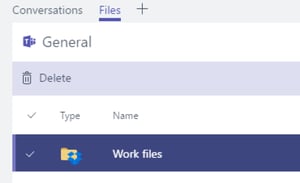B2B Marketing Content Strategy: Version Control Earns Trust
April 23, 2020

A B2B marketing department has a wide range of written collateral stored in-house, ranging from copy drafts of blogs to approved infographic and landing page copy. These are typically stored in some type of content repository for easy retrieval and for repurposing assets in the long term.
All these assets are “touched” by a variety of content production workers and expert reviewers during the collaboration process, all in the spirit of producing an effective, attractive, and purpose-driven piece of content.
Digital asset management that prioritizes document naming conventions brings order to the potential chaos associated with B2B marketing production challenges.
When you place hundreds of documents into a repository, there needs to be some kind of hierarchical organization so that production staff and project managers can find what they need, when they need it. Just as important, an organized system helps in the preservation of the written expertise implemented by SME reviewers and requests made by clients and stakeholders.
Companywide processes should be implemented and adhered to in order to track edits made by internal reviewers and clients and to ensure version control throughout the entire workflow. Doing so will not only increase production efficiency, but it will also earn trust from your clients and stakeholders in your marketing agency’s ability to execute optimized and effective B2B marketing content.
Storage and Access of Written Content
 Unified communication and collaboration platforms (like Microsoft Teams, for example) play a pivotal role in ensuring the smooth production of B2B marketing assets, as well as the preservation of edits.
Unified communication and collaboration platforms (like Microsoft Teams, for example) play a pivotal role in ensuring the smooth production of B2B marketing assets, as well as the preservation of edits.
While collaboration tools such as chat and virtual meeting functions are key to file-progression communications, the file storage capability of these platforms is the glue that holds it all together.
Several basic operations can be performed on a content item stored in a repository:
- Store – in a channel organized by folders
- Move – to a folder categorized by production phase
- Copy – in preparation to make reviewer edits in Track Changes
- Track – the evolution of written content for projects
- View – before handing copy over to stakeholders
- Search – to add or edit project planning documents
To bring structure to the collaboration process of digital marketing assets, documents can be stored within these platforms as versions. This allows a project manager to see the evolution of written content as it moves through the process, including copywriting, quality assurance, strategist or SEO review, and subsequent implementation of client edits.
Each review should be hosted in a separate document and be labeled in an identifying way (see naming conventions below). This type of content trail means that each person who has made edits can be identified and that the document itself or parts of the document could, if needed, be rolled back to an earlier version based on client feedback or stakeholder discretion.
Document Naming for Version Control
For effective digital asset management during all these review phases, written materials must be labeled according to phase to preserve version history. Companies typically issue a preferred naming convention for each step of the process, ensuring the smooth and accurate transition of a document from copywriter to reviewer to client to publication.
At TSL, for example, we follow these file-naming conventions for the first stage of production:
- Writer’s initial draft:
Company – Asset Type – Topic – R0.docx
- Strategist or SEO Reviewer edits:
Company – Asset Type – Topic – R0 Strategist Edits.docx
- Copywriter’s acceptance and approval of strategy review doc:
Company – Asset Type – Topic – R0 v2.docx
- Proofreader’s changes to draft:
Company – Asset Type – Topic – R0 – QA EDITS.docx
- Copywriter’s finalized version:
Company – Asset Type – Topic – R0 – FINAL.docx
The second phase of copywriting will look like this:
- Client’s marked-up edits in draft:
Company – Asset Type – Topic – R1 – CLIENT EDITS.docx
- Copywriter’s implementation of client edits:
Company – Asset Type – Topic – R1.docx
- Proofreader’s changes to R1:
Company – Asset Type – Topic – R1 – QA EDITS.docx
- Copywriter’s finalized version:
Company – Asset Type – Topic – R1 – FINAL.docx
Benefits of Document Management and Control
Your stakeholders and clients know what they want in order to promote a product or service, and your strategists and SEO experts know what it takes to get companies found in search for potential conversions. Their valued opinions and suggestions should be preserved throughout the production process and witnessed upon publication.
Enforcing companywide procedures and conventions ensure that these edits and alterations are implemented and carried through to publishing, not lost in the shuffle of collaboration and file-sharing.
Here are 3 long-term benefits of document and edits preservation:
- When clients or stakeholders see that their suggestions were taken seriously and abided by, trust is increased in your marketing department’s ability to listen, take direction, and stay consistently organized.
- In the very competitive land of search, companies are striving to increase their website's organic visibility. Edits implemented by SEO experts increase the chances of this positive outcome.
- Conversion is always at the forefront for service providers. B2B marketing strategists understand the language that will steer users in the direction needed to complete the desired action. Their edits to copy reduce distractions and prompt potential clients to request more information, sign up for a demo, or download your marketing assets.
Restoring Order to Digital Asset Management
There’s no doubt that ensuring version control of B2B marketing content can be a headache. It takes time, effort, and internal buy-in and across-the-board cooperation from your team members.
These naming conventions and processes should be posted as internal resources in an area accessible to all those involved in copy creation and copy review. All marketing team members should participate in discussion and training to ensure they know the process, consistently implement the naming conventions, and understand the relationship between edits preservation and the establishment of trust.
If you’re struggling with copy control or you desire any of the strategy expertise mentioned above, please reach out. We can help with all things copy creation.
